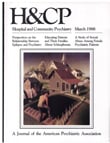A Model for Predicting Depression in Elderly Tenants of Public Housing
Abstract
To assess the prevalence of and risk factors for depression in an older population, the Multilevel Assessment Instrument (MAI) and the Center for Epidemiological Studies Depression Scale (CES-D) were administered to 176 elderly residents of a public housing apartment building in Indianapolis. The 41 patients diagnosed by the CES-D as depressed had significantly lower scores on MAI measures of psychological adjustment, cognitive function, and physical health compared with the nondepressed respondents and were more likely to have had episodes of anxiety and depression in the year before the study. Four variables—respondents' overall physical health as measured by the MAI, days spent sick in bed during the past year, livmg alone, and educational level—explained some of the variance between the CES-D scores of the depressed and nondepressed patients. A model for predicting current levels of depressive symptomatology based on scores on each of these four variables distinguished the depressed from the nondepressed tenants more than 80 percent of the time.
Access content
To read the fulltext, please use one of the options below to sign in or purchase access.- Personal login
- Institutional Login
- Sign in via OpenAthens
- Register for access
-
Please login/register if you wish to pair your device and check access availability.
Not a subscriber?
PsychiatryOnline subscription options offer access to the DSM-5 library, books, journals, CME, and patient resources. This all-in-one virtual library provides psychiatrists and mental health professionals with key resources for diagnosis, treatment, research, and professional development.
Need more help? PsychiatryOnline Customer Service may be reached by emailing [email protected] or by calling 800-368-5777 (in the U.S.) or 703-907-7322 (outside the U.S.).



